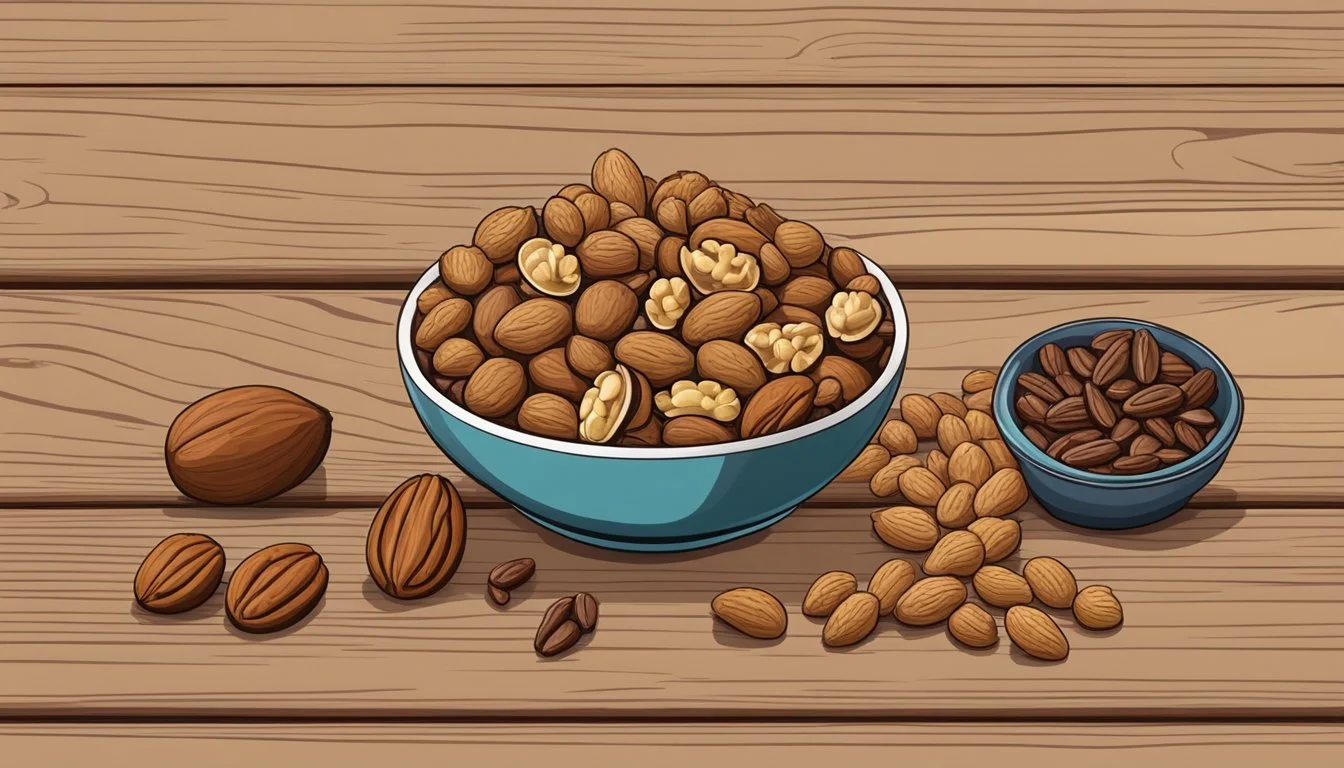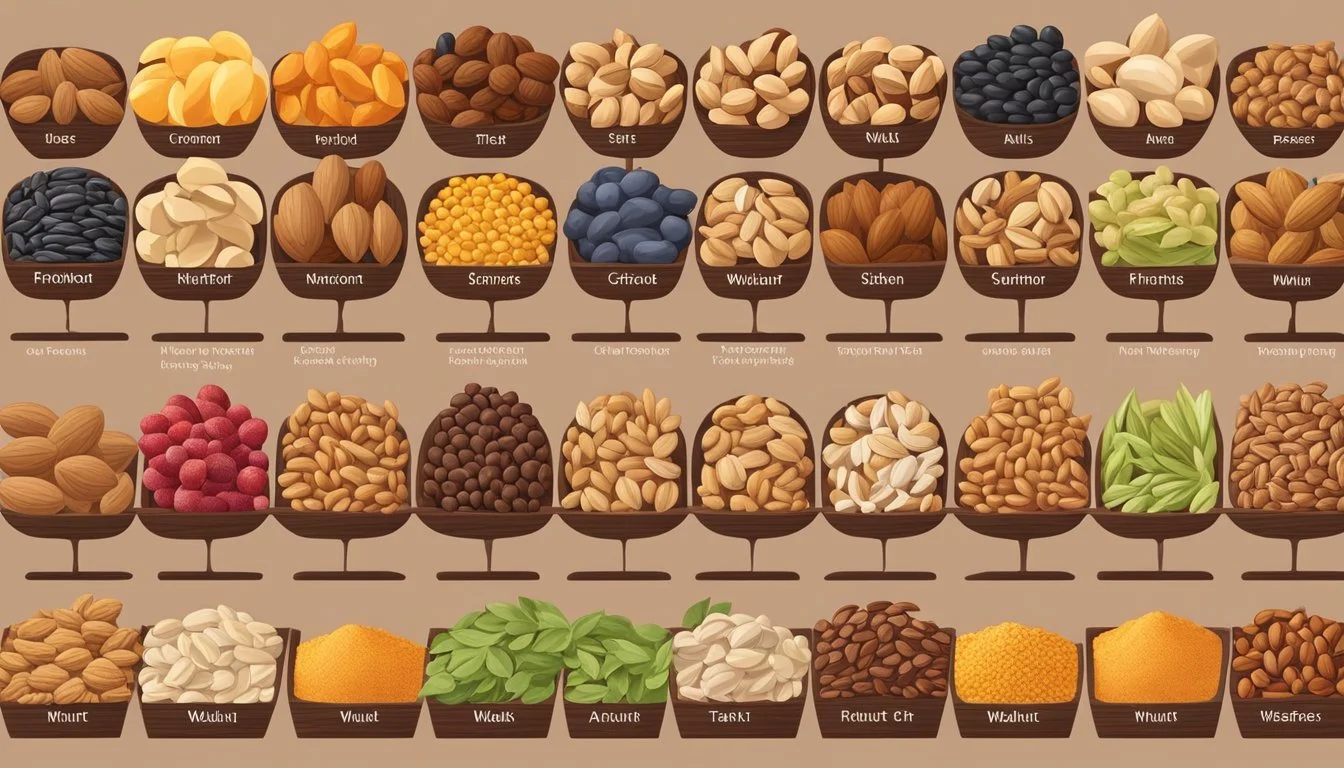Walnut Substitutes
Top Alternatives for Baking and Cooking
When looking for substitutes for walnuts in recipes, it's important to consider the role that walnuts play in the dish. Walnuts are known for their unique texture and subtle earthy flavor, often adding a crunch to baked goods, salads, and more. However, due to nut allergies or simply a lack of walnuts on hand, alternatives are sometimes needed. Many seeds and nuts offer similar textures and can complement the flavors in a variety of dishes.
For those with nut allergies, seeds such as pumpkin, sunflower, sesame, flax, and chia seeds provide a safe and nutritious alternative, with the ability to mimic the texture of crushed walnuts in baking. Each of these seeds brings its own health benefits and distinct taste to a dish. On the other hand, if allergies are not a concern, nuts like pecans, almonds, and macadamia nuts can be used to replace walnuts in recipes. Pecans closely resemble the texture and flavor profile of walnuts, making them an excellent swap in most recipes.
The choice of walnut substitute can depend on the specific requirements of the recipe and the desired outcome. Nut alternatives can often directly replace walnuts in equal measure, while seed substitutes might require some adjustments in quantity or preparation method to achieve the best results. It is crucial to select an alternative that both complements the flavors of the dish and meets any dietary restrictions of those who will be enjoying the meal.
Nutritional Considerations of Walnut Substitutes
When seeking alternatives to walnuts, it's essential to consider how these substitutes align nutritionally, particularly concerning protein, omega-3 fatty acids, healthy fats, and minerals.
Protein Content
Nuts and seeds often serve as reliable sources of plant-based protein. Substitutes for walnuts, such as pecans and Brazil nuts, typically offer protein content that is comparable to that of walnuts. For example, while walnuts contain about 15 grams of protein per 100-gram serving, pecans provide slightly less, with approximately 9 grams of protein per 100 grams.
Omega-3 Fatty Acids
Omega-3 fatty acids are vital for maintaining heart health and reducing inflammation. Flax seeds and chia seeds are excellent walnut substitutes that are also rich in omega-3 fatty acids. Typically, 100 grams of flax seeds contain about 22.8 grams of omega-3, making them a superior source of this nutrient compared to walnuts, which contain around 9 grams per 100 grams.
Healthy Fats and Minerals
Walnuts are known for their healthy fats, including monounsaturated and polyunsaturated fats, which are beneficial for heart health. Substitutes like macadamia nuts are similarly rich in healthy fats. They also offer vital minerals like magnesium and potassium. To illustrate, a 100-gram serving of macadamia nuts has about 76 grams of fat, mostly monounsaturated, and provides significant amounts of both magnesium and potassium.
Taste and Flavor Profiles
When seeking walnut substitutes, understanding the taste and flavor profile is essential to ensure a seamless transition in recipes.
Matching Walnut Taste
Walnuts are known for their distinctive earthy flavor and a slight bitterness that can enhance savory and sweet dishes alike. Pecans are the closest match in taste to walnuts, offering a similar earthy note with a hint of sweetness. They have a rich, buttery taste, but they tend to be slightly sweeter than walnuts. Almonds, while milder, can sometimes serve as a substitute due to their nutty and somewhat sweet profile. Hazelnuts, with a pronounced and unique flavor, can also replace walnuts in some instances; they impart a stronger, more aromatic taste.
Flavor Pairing with Foods
Walnuts have a versatility that allows them to pair well with a wide range of foods from salads to baked goods. A substitute should complement the ingredients in the recipe without overwhelming them.
Pecans: They share walnut's affinity for recipes like pies and cookies. The rich and savory quality of pecans can enhance the depth of flavor in such dishes.
Almonds: Their mild flavor makes them suitable for dishes where a softer taste is desired, pairing well with fruits and chocolates.
Hazelnuts: They offer a robust flavor suitable for pairing with strong ingredients like dark chocolate or rich meats. Chestnuts, with their sweet and nutty profile, can be a good match for poultry and vegetable dishes where a less pronounced nut flavor is preferable.
Through careful selection of substitutes, one can maintain the integrity of the dish's flavor profile.
Textural Similarities and Differences
When choosing a walnut substitute, one should consider both the textural attributes and how they present visually. While some alternatives offer a comparable crunchiness and mouthfeel, others might differ visually when incorporated into dishes.
Crunchiness and Mouthfeel
Pecans: They exhibit a crunchiness akin to walnuts, yielding a similar mouthfeel. Their rich, buttery flavor complements the texture, making them an ideal substitute in recipes where such sensory experiences are desired.
Chestnuts: On contrast, chestnuts provide a softer texture. Their starchy composition leads to a more yielding bite, which may not mimic the firmness of walnut pieces as accurately in a dish.
Croutons: For non-nut options, such as replacing walnuts in salads, croutons can offer a comparably satisfying crunch. Texture-wise, they are an excellent stand-in for providing a contrasting mouthfeel amidst softer ingredients.
Visual Appeal in Dishes
Chopped Nuts: Chopped pecans can closely resemble chopped walnuts, maintaining the visual integrity of dishes. The similarity in shape and size means that to the untrained eye, pecans can pass as walnuts.
Maple or Cherry Woods: In wooden applications, such as in crafted goods or utensils, maple and cherry woods share a warm visual appeal with walnut. Their grain and color can mimic the aesthetic walnut is prized for, although they have their own unique characteristics.
Specific Walnut Substitute Options
When searching for walnut substitutes, it's important to consider the desired texture and flavor profile in a given recipe. Options range from other tree nuts to seeds and nut-free alternatives, enabling accommodations for various dietary preferences and allergies.
Tree Nut Alternatives
For those not restricted by nut allergies, several tree nuts can offer similar qualities to walnuts:
Pecans: These have a comparable shape and texture to walnuts, with a somewhat richer flavor. They are versatile and can be used in most recipes calling for walnuts.
Almonds: Known for their distinctive sweet taste and firm texture, almonds can be chopped and used in place of walnuts for a slightly different flavor.
Hazelnuts: Offering a rich, aromatic flavor, hazelnuts can effectively replace walnuts and are especially good in baked goods.
Brazil Nuts: These are larger and creamier, but when chopped, they can mimic the meaty texture of walnuts in many dishes.
Cashews: With their mild taste and smooth texture, cashews are a good choice for creamy dishes or sauces.
Pistachios: These add a vibrant color and a subtly sweet, nutty flavor to dishes as a walnut substitute.
Macadamia Nuts: Their buttery and sweet taste can enhance the flavor profile of desserts and savory dishes alike.
Pine Nuts: These small nuts add a delicate flavor and a slight crunch, suitable for pestos and salads.
Seed Alternatives
Seeds are excellent substitutes for walnuts, especially for those with nut allergies:
Sunflower Seeds: They can be used whole as a crunchy addition to salads or ground as a replacement for walnut pieces in baked items.
Pumpkin Seeds: These seeds provide a similar texture to chopped walnuts and work well in both sweet and savory recipes.
Sesame Seeds: With their tiny size, they're best suited to replace ground walnuts or as a topping in recipes.
Hemp Seeds: A nutritious option, offering a soft texture and a nutty flavor when sprinkled over dishes.
Poppy Seeds: Small but flavorful, they're typically used in baked goods, dressings, and crusts.
Chia Seeds: Highly absorbent and gelatinous when wet, chia seeds are a healthy alternative to ground walnuts in puddings and smoothies.
Flax Seeds: Ground flax seeds are often used as a binding agent in baking and can serve as a walnut substitute, contributing a mild, nutty flavor.
Nut-free Alternatives
For those avoiding nuts completely, some legumes and products can act as stand-ins:
Chickpeas: Roasted chickpeas can provide the crunch and nutritional benefits one might seek from walnuts, suitable for savory dishes and salads.
Using these alternatives can cater to different dietary needs while maintaining the integrity and enjoyment of the original recipes.
Culinary Uses and Applications
When it comes to the culinary uses and applications of walnut substitutes, each alternative brings its own unique qualities to a variety of dishes. These substitutions not only maintain the integrity of the original recipe but can also add new flavors and textures.
Substitutes in Baking
In baking, nuts contribute both flavor and structure to the final product. Pecans stand out as an excellent replacement for walnuts, fitting seamlessly into dishes such as banana bread and brownies due to their similar texture and rich taste. Almonds, with their slightly crunchy texture, also perform well, particularly when used in ground form for granola bars or mixed within oatmeal cookies.
Banana Bread: Pecans can match the texture of chopped walnuts.
Brownies: Switching to pecans or almonds yields a similar richness.
Additions to Salads and Savory Dishes
Walnut alternatives for salads and savory dishes should complement the main ingredients without overpowering them. Almonds enhance salads with their subtle sweetness and satisfying crunch. For cooked dishes like stews or sauces, chestnuts can offer a starchier texture and a sweet, nutty flavor that enriches the overall taste experience.
Salads: Almonds add a sweet note and a textural contrast.
Cooked Dishes: Chestnuts provide a soft, nutty profile ideal for creamy sauces and fillings.
Homemade Snack Mixes
Snack mixes benefit greatly from a variety of textures and tastes. Seeds such as pumpkin and sunflower seeds substitute walnuts providing a hearty crunch. Smaller seeds, including sesame, flax, and chia, are suitable for a more delicate texture in granola mixes or as a topping over rolled oats.
Granola: Sesame or flax seeds can be mixed in for a nutrient-dense crunch.
Snack Mixes: Pumpkin and sunflower seeds give a robust bite suitable for on-the-go snacking.
Allergy Considerations and Safe Practices
When cooking for individuals with nut allergies, understanding the allergies, avoiding cross-contamination, and attentive labeling are critical for safety.
Recognizing Common Nut Allergies
Nut allergies are serious and can be life-threatening, with tree nuts and peanuts being among the most common triggers. Tree nuts include walnuts, almonds, hazelnuts, cashews, pistachios, and Brazil nuts. It's important to note that some individuals may be allergic to all tree nuts, while others might react to only specific types.
Cross-contamination Concerns
In kitchens where nuts and nut-free items coexist, cross-contamination is a significant risk. Utensils, surfaces, and hands should be thoroughly cleaned after contact with nuts. To minimize risks:
Use separate cooking and preparation tools for nut-containing and nut-free foods.
Clearly designate storage areas for nut-free ingredients.
Implement protocols for regularly sanitizing surfaces.
Labeling and Packaging
Accurate labeling and packaging are key components in allergen management. Manufacturers must list all potential allergens, including tree nuts and peanuts, but individuals preparing food at home should also:
Clearly label home-made foods as "nut-free" when applicable.
Pay attention to packaging labels that might indicate traces of nuts or state "manufactured in a facility that processes nuts."
Be wary of cross-reactivity with foods processed in shared facilities.
Economic and Accessibility Factors
When considering substitutes for walnuts, it’s essential to take into account the economic and affordability aspects along with the availability and seasonality of alternatives.
Cost-Effective Substitutes
In terms of cost-effectiveness, pecans often stand out as a prime substitute for walnuts. They are similar in taste and texture, yet can vary in price. Pecans are a smart choice, especially when prices for walnuts rise due to fluctuating market demands or reduced harvests. Consumers also turn to nut-free options like seeds -- sunflower or pumpkin seeds, for instance -- as they can be cheaper and readily available year-round.
Availability and Seasonality
The availability of walnut substitutes can widely vary depending on the region. In some areas, pecans are as readily available as walnuts, particularly in the United States where pecan cultivation is substantial. However, the seasonality of nuts implies that at certain times of the year, substitutes like almonds or hazelnuts might be more accessible. For consumers in areas where certain nuts are not locally grown, imported substitutes could be less economical due to shipping and handling costs.
Environmental and Sustainability Considerations
When assessing walnut substitutes from an environmental and sustainability perspective, one must consider the ecological footprint of alternative crops. Walnuts are known for their water-intensive cultivation; thus, substitutes may offer water conservation benefits.
Walnut substitutes can be integrated into crop rotations, enhancing soil health and reducing reliance on chemical fertilizers.
Biodiversity:
Alternatives to walnuts may support biodiversity by requiring pollinators or providing habitat for wildlife, contributing to ecosystem resilience.
Greenhouse Gas Emissions:
Substitutes that require less fertilizer and machinery use can result in lower greenhouse gas emissions compared to traditional walnut farming.
Land Use Efficiency:
Efficiency in land use is crucial. Some substitutes may yield more food per acre, preserving natural habitats from agricultural expansion.
It is important to evaluate these factors meticulously to ensure a positive impact on sustainability efforts.








